Contributed by: Dirk Fabricius, SAD Accredited Facilitator on April 1, 2023
Some companies have steep hierarchies where managers are labeled by letters and numbers. When discussing these positions, it can sound like a game of chess: “F2 to E1.” This case study features one such company that, until recently, was a moderately happy place where development teams even deployed code from time to time. However, according to an article in a management magazine, they were not performing among the top 5% of companies worldwide, such as Google, Apple, Facebook, and Amazon. As a result, management decided to implement the Scaled Agile Dev Ops Maturity Framework, which, surprisingly, nobody at Google, Apple, Facebook, or Amazon had ever heard of. This article shares their success story, implementation roadmap, and important tips for anyone considering implementing this or any other scaling framework.
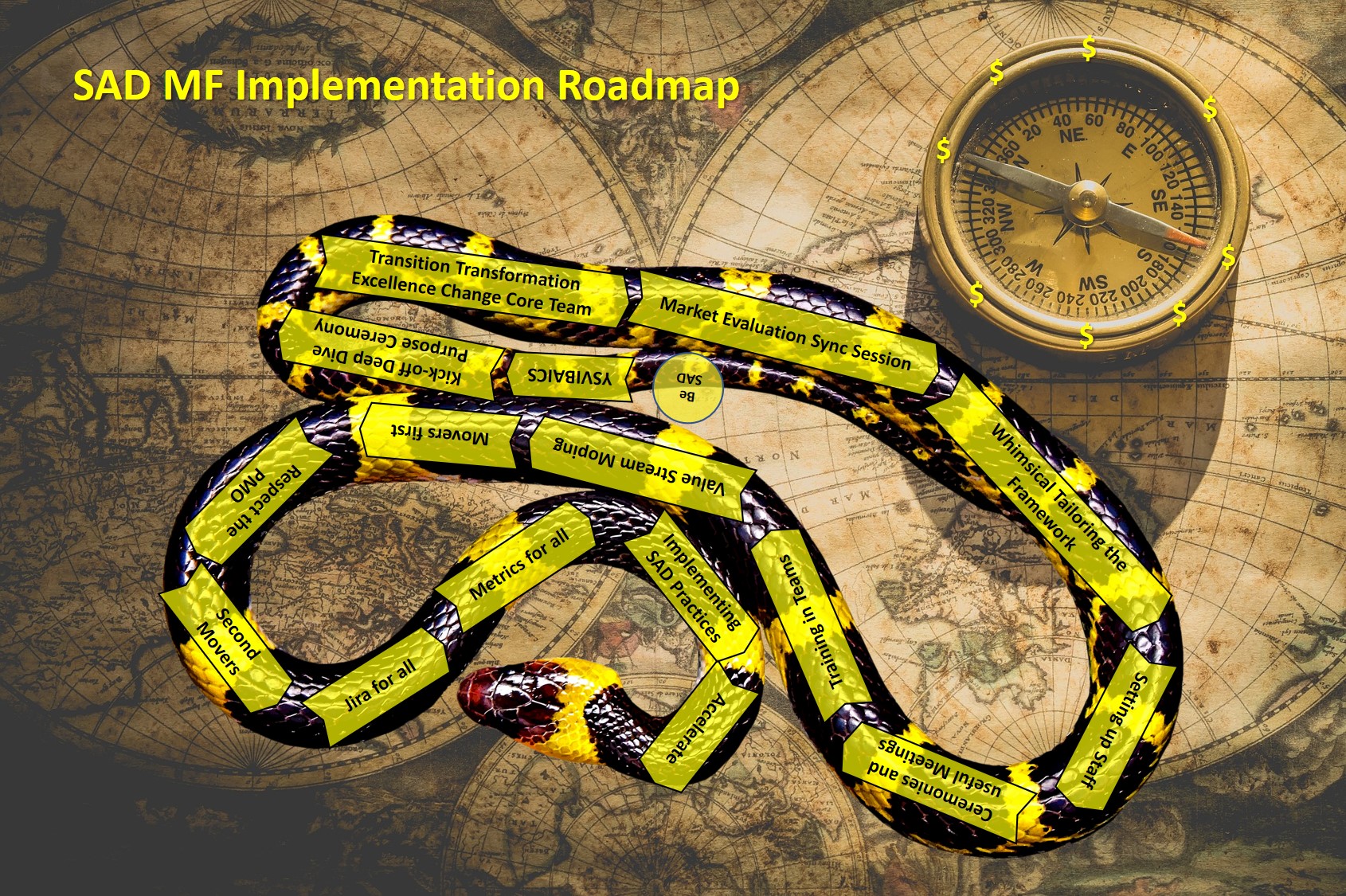
- Pix by Vizetelly and Ylanite Koppens at PixaBay
Be Scaled Agile DevOps Maturity Framework
The SAD thought leaders claim that it’s not about doing SAD, but about being SAD. This has no meaning at all, but it is nice for inspiring quotes right at the start of a case study. Place the tokens of all players here.
Yearly Strategic Very Important Budget Allocation Initiation Committee Session (YSVIBAICS) #
Implementing a framework like SAD needs a waterfall initiative — a fancy word for a project. Successful initiatives consist of a title that management will copy and paste into every email, every presentation, and every document during the initiative as some kind of “important” tag. Second, there is a budget that management needs to hire external consultants to create fancy slides and go out for lunch.
In this case, management came up with an innovative title, calling it the “DevOps Initiative.”
Hint:
Don’t be too specific here. You can still do whatever you like with your new budget. No one really knows what DevOps is about. You can even implement a scaling framework of your choosing and claim this was planned all along.
Kick-off Deep Dive Purpose Ceremony #
Management had to choose some random words to recite when someone asks them what the initiative is about. They crafted these words into a sort of knightly oath to make it sound like they know what they’re talking about and won’t get any further questions: Focus! Alignment! Transparency! They also made sure the words weren’t used in their last initiative and created a fitting mnemonic: FAT!
A word of caution: If you have been measuring effectiveness in your company, it’s best to stop doing so at this point. It’s irresponsible to measure productivity during a change initiative. Instead, you will eventually generate enough metrics, and you can select the ones that make you look good to give to your boss. Never measure beforehand because this would make your work transparent (bad), instead of the work of your resources (good). Change is hard for resources, and since you hired them, you must assume that they might mess everything up. Without any tangible data at the start, you can claim that any recovery is due to your successful initiative.
Transition Transformation Excellence Change Core Center Team (TTECCCT) #
According to Sunzi, a manager needs every other manager to frequently swear allegiance to them during an initiative. Not because they need to do any actual work — this will be done by the hired consultants. Management could easily get rid of anyone who hesitates to pledge allegiance during the initiative without anyone else noticing or complaining.
The consultants that were hired were misleadingly called Agile Coaches, despite not being agile nor coaching effectively. The company had a convoluted system for defining job titles and compensation. An Agile Coach was worth less than an Enterprise Agile Coach, but triple the worth of a Senior Scrum Master. The latter was worth two Scrum Masters. And five Junior Scrum Masters were equivalent to one Scrum Master. In this system, the three coaches were worth approximately ninety Junior Scrum Masters.
Management assembled a team with a catchy name, consisting of the three consultants, colleagues who feared them the most, and those who constantly brown-nosed them. These people will take the blame should the initiative fail and are responsible for controlling the narrative during the initiative. The team was given a “core” label so that they can invite other resources for fun and kick them out without any questions asked. This way, the new team can claim that everyone was somehow involved, thereby shifting the blame downwards and further away from management. The decision was made, that TTECCCT internally is referred to as The Team That Everyone Can Count on to Cover Their Tracks which they could memorize better.
Hint:
Ensure that the new team communicates with each other at least three times in something called a sync session, which is short for talk. They are not allowed to write anything down before, during, or after this sync in order to train their memory. However, make sure they use a Kanban board so that they can claim they are practicing agile project management. Just be sure not to reflect any decisions or other important topics on the board.
Market Evaluation Sync Session (MESS) #
Choosing a framework was easy since the consultants only knew about the Scaled Agile DevOps Maturity Framework. For team building purposes, management had the TTECCCT meet and asked them to create a collage of logos from at least five SAD competitors by searching for them on Google.
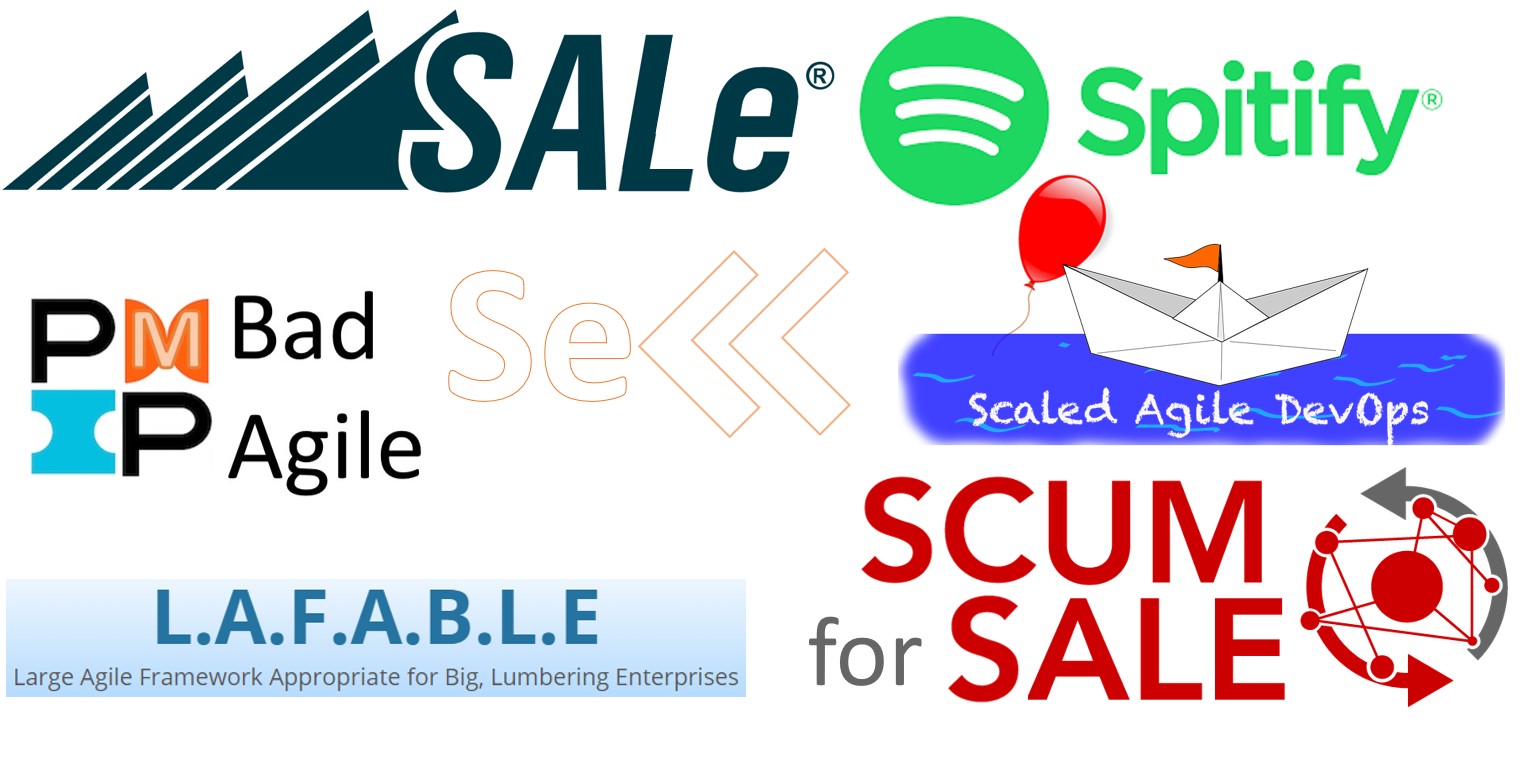
- All logo rights are reserved by their owners.
Hint:
Claim to have evaluated and be proficient in these frameworks and present your new approach as inspired by all of them.
Whimsical Tailoring of the Framework (WTF) #
Consultants often have short attention spans and only read a few pages of the Scaled Agile DevOps Maturity Framework online. Therefore, they claimed it would be beneficial to “tailor” the framework to the company’s needs by removing everything they didn’t read or understand. As a result, management dropped every principle, practice, and most of the recommended metrics, and focused only on roles and ceremonies.
Hint:
The largest out-of-the-box implementation of SAD comes with only sixteen new roles. This may not be enough, but you may define new roles at any later date.
Setting up Staff (SuS) #
The SAD roles were quickly distributed among the TTECCCT. Members also received complete freedom to add additional phrases to their roles to emphasize their immense importance in the transformed organization. They also redefined preexisting roles to ensure that the resources knew their place. After all, transitions are about protecting the fiefdoms.
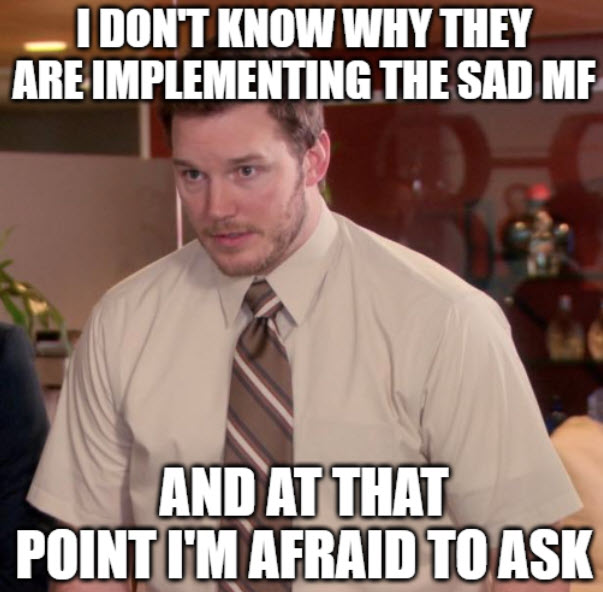
Hint:
Redefining previously existing roles can be accompanied by renaming them, but it is not necessary. You can add a prefix like “Area” or “Component” to restrict those colleagues to a specific division. Alternatively, you can add a suffix like “Team” or “Coach” to ensure that a role remains within their team and doesn’t report to management. In this company, they simply redefined the old roles and claimed it had always been that way.
If TTECCCT staff members want to claim the title of a group as their role, it is acceptable. Create a nice email distribution list for them. There is nothing wrong with the Enterprise Architecture Review Board (EARB) being a single resource governing software architecture. The same goes for TTECCCT members who claim multiple roles for themselves. With the end of the era of business cards, the only limit here is the length of an email signature, which provides so much space for creative role combinations. Help them not to take on too many contradicting roles at once to keep the company’s expenses for treating multiple personality disorder in check. Make sure the TTECCCT runs a spell check over the results so that they don’t embarrass themselves too much.
Ceremonies and Useful Meetings #
The SAD MF out-of-the-box comes with thirteen ceremonies, but management believed that they were taking up too much time and wanted the resources to focus on coding instead. Each TTECCCT member had already chosen some of these thirteen ceremonies to serve as their personal mandatory underling mistreatment (mum) meeting. The consultants negotiated a compromise: keep all ceremonies, but reduce their duration to a quarter of the original time while still demanding the same output as before. It was clear, that the quality of plans might suffer by this, so the TTECCCT decided to rename “plan” to “precise but also vague premonitions.” It has also been decided not to whip resources in public should not all parts of their precise but also vague premonitions come true. However, all other management tactics, including death marches and Shturmovshchina, are still fair game.
Hint:
As management, demand to be invited to all of the thirteen ceremonies, being the lord-stakeholder-savior-god- owner by now. Show up spontaneously without accepting, declining, or using any further functionality of your calendar tool. If you decide to participate in a ceremony, talk at least 50% of the timebox on a random topic of your choosing. You are not limited to the ceremonies. If you want to check on some resources, simply set something up and call it a meeting, 1:1, sync, exchange, or leave it at default. Don’t provide an agenda — you don’t prepare, why should anyone else? Expert tip: With just two clicks, you can also make this a recurring meeting that you can drag around for fun.
Training in Teams (TiT) #
Regardless of what the SAD MF says, there is no need for training the resources since everything is readily available on the SAD website. Management probably also forgot possible training expenses in their YSVIBAICS.
Hint:
If you really need additional information check out the compatible Certified Really Agile Practitioner on YouTube. Get administration to unblock YouTube in the company firewall settings first.
Value Stream Moping (VSM) #
One of the TTECCCT consultants once read a book, article, overheard a conversation on the subway, or dreamed about identifying streams of value in every company before employing the SAD MF convoy on them. Management somehow liked the idea of streams— water that flows quickly in a single direction — without their resources having to lift a finger, rarely changing course, and never needing feedback loops.
Hint:
Do not really conduct any Value Stream analysis. Simply draw the desired organizational chart with nice and colorful crayons, place your entourage in all crucial positions, let them choose what their branch of the organization should be named, and claim that these are the identified Value Streams. In a sense, they are really providing value to you. Also, place your own name separately at the top of all streams.
Change Management #
Movers First - Move it?
Controlling the narrative is hard when every release convoy is exposed to the SAD implementation all at once. It is recommended to only drive a smaller group of resources into madness to start with. Management claimed that the selected few are the best of the best of the best — and thereby all others clearly are not. Since every resource knows that a transformation goal is to get rid of people management doesn’t like, not being in the illustrious company of the movers first puts the living fear into them.
Hint:
Should a resource ask questions at this point, claim they are not yet in a mature state according to the change curve shown below. The consultants certainly would be willing to work on the resource’s values, principles, behaviors, culture and religious belief systems to help them overcome their negativity and transition to compliance.
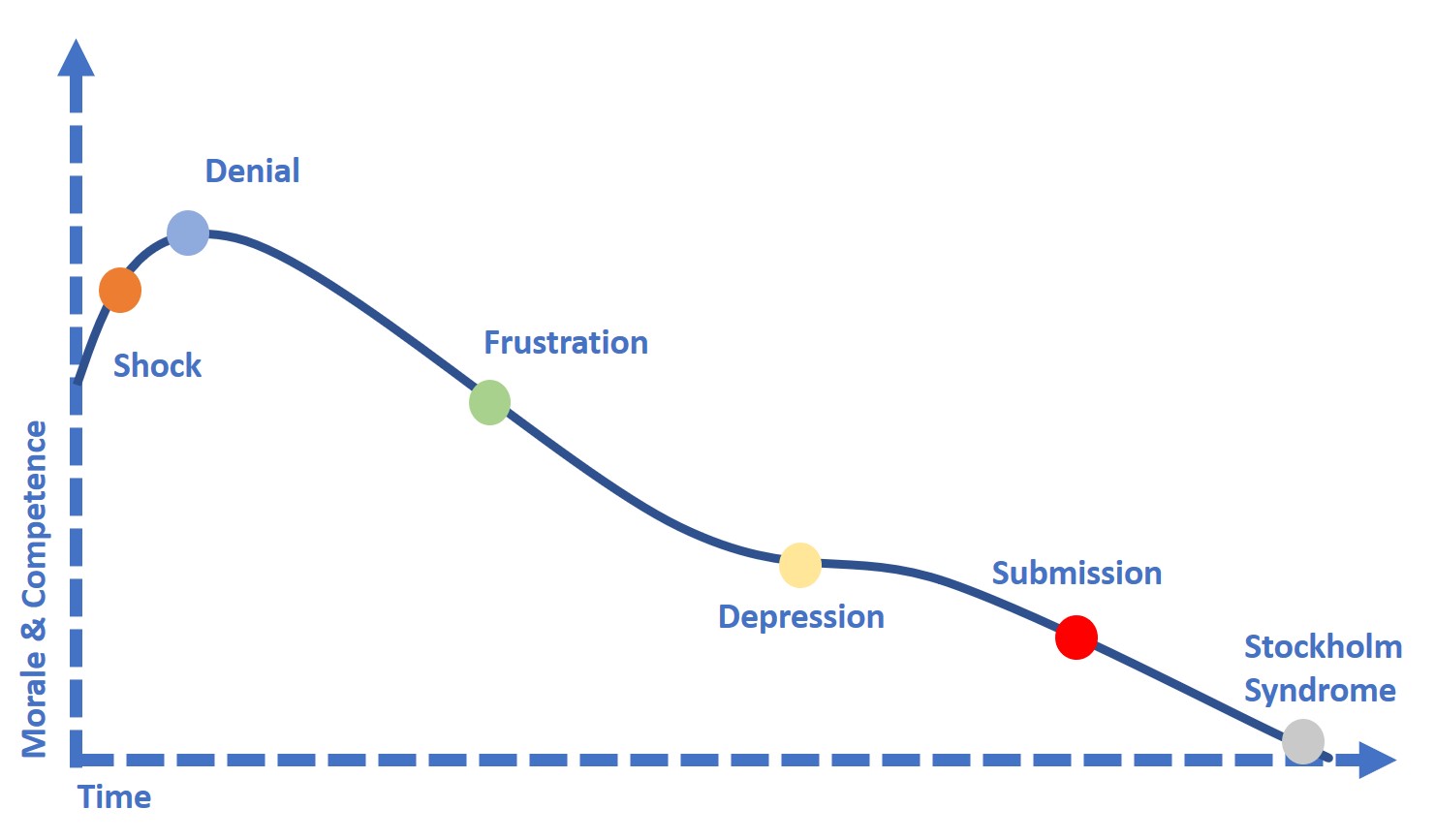
- Adapted from Dr. Elisabeth Kubler-Ross, 1969
Transformations to the SAD MF — as all other transformations — fail frequently and miserably. One simple reason is that management forgets to let go of some unnecessary resources during, or at the start of, the transformation. Those eventually might begin to notice they aren’t invited to meetings anymore, and possibly gang up on management, making use of their newly found time. Management didn’t fall into this trap and made up additional roles for those resources right from the start.
Hint:
To make the roles sound more important and desirable, add a prefix to their title such as “Senior,” “Executive,” or “Strategic.” Also, include the new framework to make sure they know whom to thank for still having a job. For example, “Senior SAD Requirements Engineer,” “Executive SAD Project Manager,” “Strategic SAD Quality Engineer,” “SAD Leader of Innovation.” Also, create a RACI matrix for all roles adding multiple random letters everywhere like a spilled alphabet soup. Make sure to include an “I” for “informed” alongside your own role for every task listed. Put an Nomen Nominandum or a tbd in the last line of the RACI matrix to remind everyone that this isn’t final. You now can make the whole life of a resource and their families miserable by changing a single letter in an MSExcel sheet — how is this for power?
Second Movers
At some random point, management declared that the Movers First had succeeded and withdrew all supporting consultants working with them. Since the Movers First did not want to admit any failure, no one spoke up against this decision. Management pretended that they had learned a lot from the (repeat this multiple times to the mirror) successful(!) transition and would use these valuable insights to transform the rest of the company’s resources. They didn’t do this of course. No one wants the SAD framework to fit individual teams. Who should maintain this in the end? This is a lot of effort and the resources might forget who serves whom.
Hint:
Now, go to all of your management friends and tell them about your success. Go to the workers council, taking some management colleagues with you, and inform them of the changed circumstances and your success. Go to HR and make them post a job advert for a SAD MF practitioner to work in your successfully transformed environment. This is easier than training your own resources, and the new resource can be held responsible if your initiative runs into problems. Go to Marketing and make them write blog articles about your successful transformation.
Jira for All
This tool is part of any mushroom management initiative and by common law needs to be deployed together with DevOps, Agile, Lean, Digitization, New Work, Industrial Revolution, or any other known or future change project.
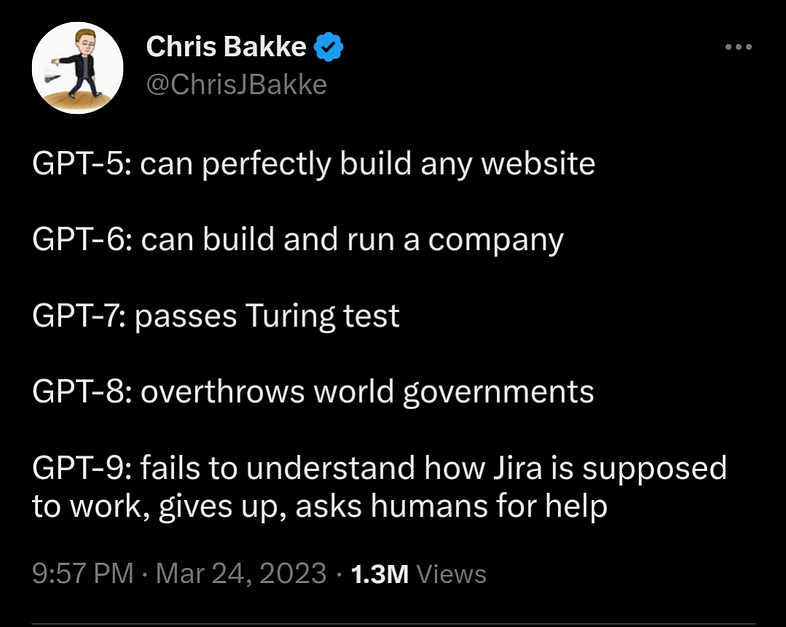
- GPT-10 understood Jira and started an all-out war against Atlassian

Management has made this a multi-level system portfolio enterprise configuration, so no single team has been able to achieve anything on their own, needing a steep hierarchy with approvals and informing management at the top for even going to the restroom. Now management is enabled to tell anyone in the newly defined organization that they are doing “it” wrong at any point in time.
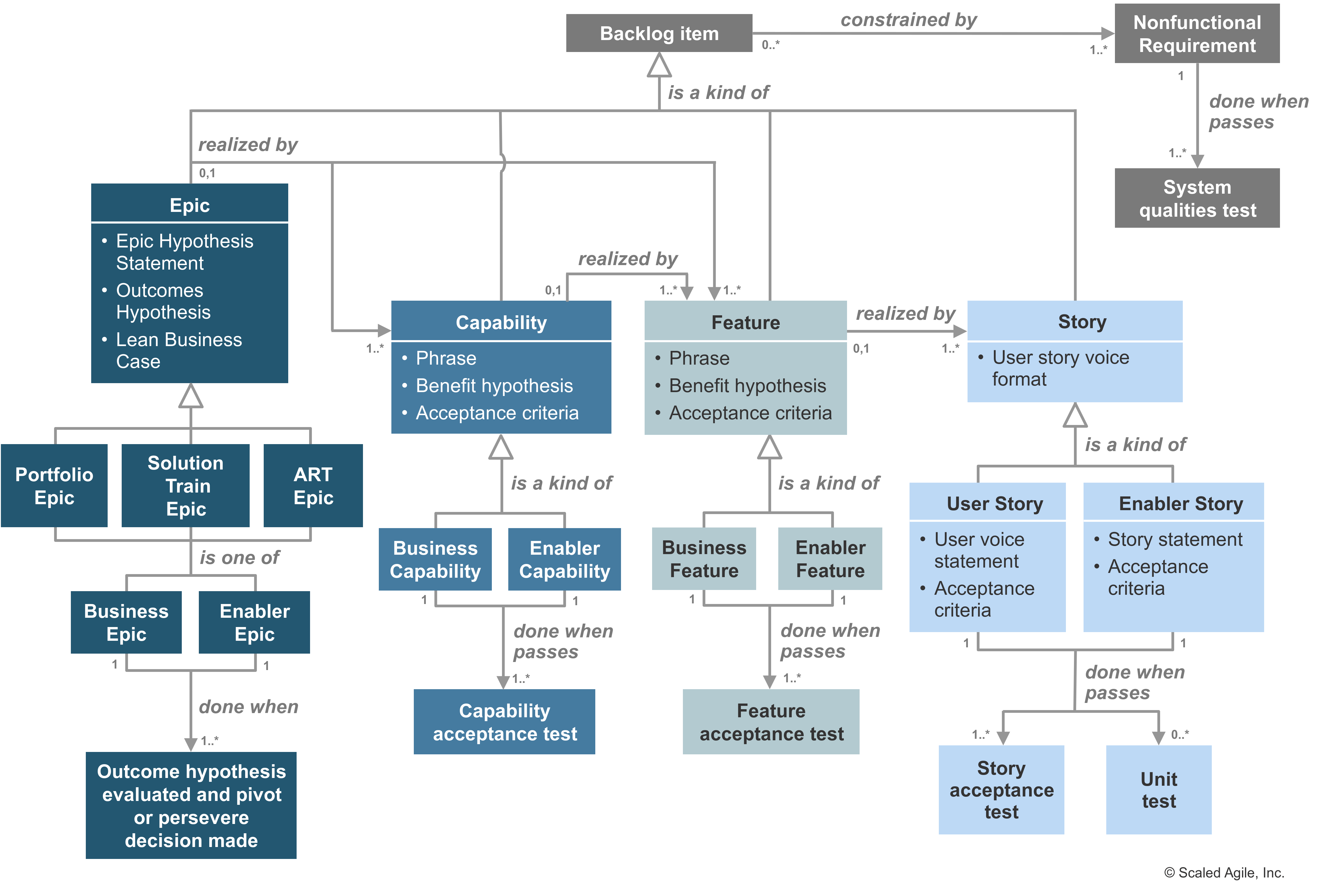
- Exaggeration just for teaching purposes — no one in their right mind would use something like this — source: <https://scaledagileframework.com/>
Hint:
The above made-up Jira work-item structure perfectly aligns with the future need for even more roles. They now can be created out of thin air. Call those “ Business Portfolio Epic Owner,” “Program Success Enabler Coach,” “Chief Capability Champion,” “Enterprise Business Feature Architect,” “Hypothesis Enabled Testmanager,” or whatever other random combination of words you like — they’ll never know.
Metrics for All #
Management claimed that nobody has been delivering any real value, but decided not to measure value. Instead, they decided to measure the speed of delivery. The DevOps initiative was declared successful, so there was no risk of metrics making management look bad anymore. They got the consultants to write Jira queries and ordered the teams to provide exactly the same numbers by hand, guaranteeing the four-eyes principle.

- Picture courtesy of BBC News Network
Hint:
Claim that the metrics everyone now has to deliver are industry standard (without specifying which industry). Also, assure everyone that you won’t compare teams or individual employees, or track employee performance throughout the day or over time. Make a big pinky-swear to emphasize your sincerity. However, still insist that all metrics be gathered in one central location for your convenience and be accessible to you at any time. With all the data in one place, any future decision can be justified simply by pointing to the metrics, eliminating the need for any tedious analytics.
Implementing SAD Practices #
Some IT resources didn’t seem to care for the power distribution in the organization at all. They have seen many transformations over the years and managed to emotionally detach completely. This was not really fun for management so they claimed for the SAD MF to work everyone, in addition, had to adhere to new practices annoying even the most resilient IT resources:
- Fixed scope, time, and cost for all projects
- Pert Chart Roadmaps for all projects
- Big Design Up Front
- Upfront Architecture
- Mortgage Driven Design
- Normalizing Story Points and separating testers and developers
- Adding up Story Points for Epics over teams
- Agile Theater once per day
- Brainfuck is the only approved development language
- On-site Innovation Thinktankalab sprintathons every third full moon
- Standardized Definitions of “we really mean it’s done this time”
Last Step — Accelerate #
Management bought the e-book “Accelerate,” but didn’t read it. They claimed that the company is now among the top 5% of enterprises according to the new made-up metrics. They went to marketing to brag on Instagram and LinkedIn about their #success and let go of all managers who didn’t give the posts a thumbs up.
Hint:
Should anything not work out— remember the newly hired SAD MF resource is responsible. Should this not be enough make clear the consultants are responsible for potential failures. In case that still is not enough, the TTECCCT will be responsible, but certainly not management.